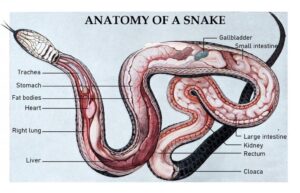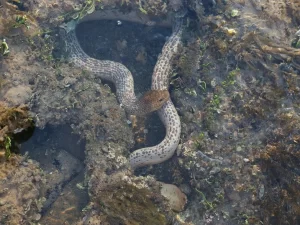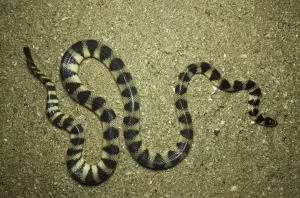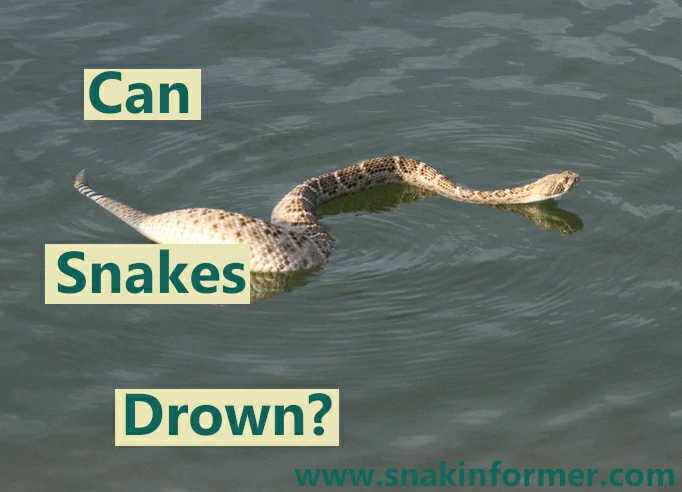Many snakes, particularly those that live close to water bodies, venture into the water for various reasons, such as to escape predators or to move across different areas of their habitat.
Snakes are air-breathing reptiles, and if their lungs fill with water, they can drown. Although many snakes can hold their breath to dive underwater, they can only stay submerged for a limited time before they need to resurface to breathe.
If a snake gets into water where it can not surface for air, or otherwise get out of the water, drowning is a real possibility.
Snakes Breathe Air With Their Lungs
Like all reptiles, snakes have lungs, that they use to breathe air.
Due to their elongated bodies, snakes do not have lungs that are located side to side, like ours.
Instead, they have one shorter and one very long lung in a series. In most species, the left lung is the smaller one and is roughly 85% of the length of the elongated right lung.
Some species only have one elongated lung, and the smaller lung is absent.

In many snakes, the smaller left lung is vestigial, and all gas exchange happens with the longer lung.
Since snakes breathe air, they can only stay submerged for a limited time before they have to resurface to replenish their oxygen stores and expel waste gases.
If a snake is submerged in water and is somehow prevented from reaching the surface to breathe, it can drown.
For example, a snake that is entangled in a fishing net may drown if it is unable to escape.
Some Snakes Can Stay Submerged for a Considerable Amount of Time
Although snakes are air-breathing reptiles, some species have adaptations that enable them to stay underwater for a considerable period of time.
A few sea snake species can even stay underwater for as long as 8 hours!
Here are 3 factors that influence how long a snake can stay underwater, without drowning.
1. Species
Some snake species are more adept at holding their breath than others and thus can stay underwater longer.
For example, Olive sea snakes (Aipysurus laevis) are known to spend up to two hours underwater before returning to the surface to breathe.

Plain-bellied water snakes (Nerodia erythrogaster) have been observed submerged underwater for several minutes, and lying in wait for prey to approach.
On the other hand, some snake species can only stay submerged a few minutes, before needing to resurface, or they will drown.
2. How Active the Snake Is
Activity affects how much oxygen the body needs.
Think about it. When you are running or jogging, you breathe in much quicker breaths than when you are lying on the couch.
For snakes, this is also true. Their oxygen demands will be influenced by their activity levels.
A snake that is resting on the bottom of the water may be able to stay submerged for quite a while.
On the other hand, an individual of the same species who is escaping a predator or chasing prey – may only be able to stay a few minutes before needing to surface to replenish its oxygen supply.
3. Temperature
Like all reptiles, snakes are cold-blooded (ectothermic) animals.
This means they cannot internally regulate their body temperature. Instead, their body temperature changes with the temperature in their surroundings.
In other, their environment is the main influence on their body temperature.
For example, a snake swimming in 30°C (86°F) water has a body temperature very close to 30°C. In water at 15°C (59°F), the body temperature is around 15°C.
Being ectothermic means snakes will have a varied rate of metabolism, depending on the water temperature.
Warmer water temperatures increase metabolic rates. This means snakes have to resurface more often to get oxygen.
On the opposite end, cooler water allows snakes to conserve oxygen. This extends the time they can hold their breath.
Some Sea Snakes Can ‘Breathe’ Underwater
Like all snakes, sea snakes need to resurface to breathe air. However, some species have found ways to top up their oxygen levels while submerged.
A team of researchers analyzed the bodies of two blue-banded sea snakes (Hydrophis cyanocinctus) – and discovered a gill-like network of blood vessels in the animals’ heads.

This complex system of blood vessels is known as a modified cephalic vascular network (MCVN).
It is located just under a broad area of skin between the snout and the roof of the snake’s head.
While the MCVN is structurally very different from the gills of fish, its function is similar. It provides a large surface area packed with oxygen-depleted blood vessels.
The oxygen-poor blood in these vessels is able to absorb oxygen from the surrounding water – through the skin.
The blood oxygenated blood is then carried to the brain – very similar to how a fish’s gills work.
In this way blue-banded sea snakes use the top of their head, as a sort of gill, to breathe underwater.
This ‘skin breathing’ is known as cutaneous respiration, and is very unusual for reptiles, because their skin is thick and scaly.
Conclusion
Snakes are some of the most widespread reptiles in the world, found on all continents, except Antarctica.
With such a wide distribution, snakes are often near water bodies.
All snakes can swim, and they often go into ponds, streams, and other water bodies to hunt, escape predators on land, or simply move across different areas of their habitat.
Some snakes that live close to water bodies obtain a large portion of their prey in the water.
Despite their adaptions, all snakes are air-breathing breathing reptiles, and generally can not breathe underwater.
They can only stay submerged for a limited time before they have to resurface to replenish their oxygen supplies.
If a snake stays submerged for a prolonged period without resurfacing, drowning is a real possibility.
How long a snake can stay submerged before drowning is influenced by several factors such as the species, and activity levels.
Sources:
By Douglas Mader, M.S., DVM, DABVP. Snake Anatomy: Know your snake inside and out with this snake anatomy introduction. (PDF).
Palci, A., Seymour, R. S., Nguyen, C. V., Hutchinson, M. N., Lee, M. S. Y., & Sanders, K. L. (2019). Novel vascular plexus in the head of a sea snake (elapidae, hydrophiinae) revealed by high-resolution computed tomography and histology. Royal Society Open Science, 6(9), 191099. https://doi.org/10.1098/rsos.191099
Dean, J. B., & Gratz, R. K. (1983). The Effect of Body Temperature and CO₂ Breathing on Ventilation and Acid-Base Status in the Northern Water Snake Nerodia sipedon. Physiological Zoology, 56(2), 290–301. http://www.jstor.org/stable/30156061
Hi, my name is Ezra Mushala, i have been interested animals all my life. I am the main author and editor here at snakeinformer.com.

